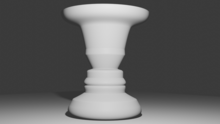
Back Gerro de Rubin Catalan Copa de Rubin Spanish Rubinen loreontzia Basque گلدان روبین Persian אגרטל רובין HE ルビンの壺 Japanese 루빈의 꽃병 Korean Vaas van Rubin Dutch Vaso de Rubin Portuguese แจกันรูบิน Thai
This article needs additional citations for verification. (November 2015) |

Rubin's vase (sometimes known as the Rubin face or the figure–ground vase) is a famous example of ambiguous or bi-stable (i.e., reversing) two-dimensional forms developed around 1915 by the Danish psychologist Edgar Rubin.[1]
The depicted version of Rubin's vase can be seen as the black profiles of two people looking towards each other or as a white vase, but not both.
Another example of a bistable figure Rubin included in his Danish-language, two-volume book was the Maltese cross.

Rubin presented in his doctoral thesis (1915) a detailed description of the visual figure-ground relationship, an outgrowth of the visual perception and memory work in the laboratory of his mentor, Georg Elias Müller.[2] One element of Rubin's research may be summarized in the fundamental principle, "When two fields have a common border, and one is seen as figure and the other as ground, the immediate perceptual experience is characterized by a shaping effect which emerges from the common border of the fields and which operates only on one field or operates more strongly on one than on the other".
- ^ Rubin, E. (1915). Synsoplevede figurer: Studier i psykologisk analyse [Perceived figures: Studies in psychological analysis]. Gyldendal, Nordisk forlag.
- ^ "Looking back: Figure and ground at 100 | The Psychologist".
© MMXXIII Rich X Search. We shall prevail. All rights reserved. Rich X Search